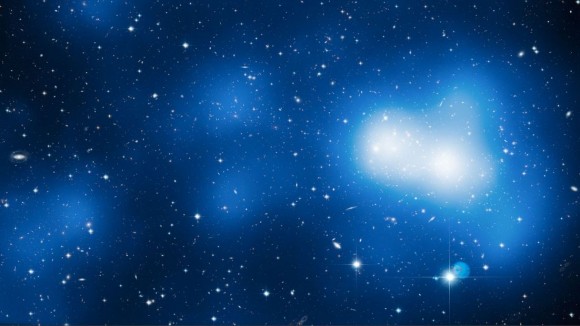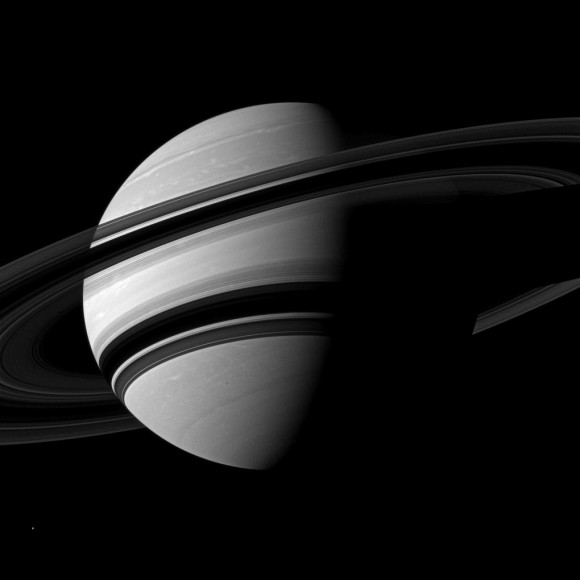Hubble Studies Dark Matter Filament in 3-D
Hubble’s view of massive galaxy cluster MACS J0717.5+3745. The large field of view is a combination of 18 separate Hubble images. Credit:
NASA, ESA, Harald Ebeling (University of Hawaii at Manoa) & Jean-Paul Kneib (LAM)
Earlier this year, astronomers using the Hubble Space Telescope were able to identify a slim filament of dark matter that appeared to be binding a pair of distant galaxies together. Now, another filament has been found, and scientists a have been able to produce a 3-D view of the filament, the first time ever that the difficult-to-detect dark matter has been able to be measured in such detail. Their results suggest the filament has a high mass and, the researchers say, that if these measurements are representative of the rest of the Universe, then these structures may contain more than half of all the mass in the Universe.
Dark matter is thought to have been part of the Universe from the very beginning, a leftover from the Big Bang that created the backbone for the large-scale structure of the Universe.
Dark matter is thought to have been part of the Universe from the very beginning, a leftover from the Big Bang that created the backbone for the large-scale structure of the Universe.
“Filaments of the cosmic web are hugely extended and very diffuse, which makes them extremely difficult to detect, let alone study in 3D,” said Mathilde Jauzac, from Laboratoire d’Astrophysique de Marseille in France and University of KwaZulu-Natal, in South Africa, lead author of the study.
The team combined high resolution images of the region around the massive galaxy cluster MACS J0717.5+3745 (or MACS J0717 for short) – one of the most massive galaxy clusters known — and found the filament extends about 60 million light-years out from the cluster.
The team said their observations provide the first direct glimpse of the shape of the scaffolding that gives the Universe its structure. They used Hubble, NAOJ’s Subaru Telescope and the Canada-France-Hawaii Telescope, with spectroscopic data on the galaxies within it from the WM Keck Observatory and the Gemini Observatory. Analyzing these observations together gives a complete view of the shape of the filament as it extends out from the galaxy cluster almost along our line of sight.
The team detailed their “recipe” for studying the vast but diffuse filament. .
First ingredient: A promising target. Theories of cosmic evolution suggest that galaxy clusters form where filaments of the cosmic web meet, with the filaments slowly funnelling matter into the clusters. “From our earlier work on MACS J0717, we knew that this cluster is actively growing, and thus a prime target for a detailed study of the cosmic web,” explains co-author Harald Ebeling (University of Hawaii at Manoa, USA), who led the team that discovered MACS J0717 almost a decade ago.
A model that combined positional and velocity information for all these galaxies was constructed and this then revealed the 3D shape and orientation of the filamentary structure. As a result, the team was able to measure the true properties of this elusive filamentary structure without the uncertainties and biases that come from projecting the structure onto two dimensions, as is common in such analyses.
The results obtained push the limits of predictions made by theoretical work and numerical simulations of the cosmic web. With a length of at least 60 million light-years, the MACS J0717 filament is extreme even on astronomical scales. And if its mass content as measured by the team can be taken to be representative of filaments near giant clusters, then these diffuse links between the nodes of the cosmic web may contain even more mass (in the form of dark matter) than theorists predicted.
Timeline: 15 Years of Cassini
The Cassini spacecraft takes an angled view toward Saturn, showing the southern reaches of the planet with the rings on a dramatic diagonal. Credit: NASA/JPL-Caltech/Space Science Institute
The Cassini mission has been a source of awe-inspiring images, surprising science and incredible longevity. Since launching on Oct. 15, 1997, the Cassini spacecraft has logged more than 6.1 billion kilometers (3.8 billion miles)of exploration – enough to circle Earth more than 152,000 times. After flying by Venus twice, Earth, and then Jupiter on its way to Saturn, Cassini pulled into orbit around the ringed planet in 2004 and has been spending its last eight years weaving around Saturn, its glittering rings and intriguing moons.
The spacecraft has sent back some 444 gigabytes of scientific data so far, including more than 300,000 images. More than 2,500 reports have been published in scientific journals based on Cassini data, describing the discovery of the plume of water ice and organic particles spewing from the moon Enceladus; the first views of the hydrocarbon-filled lakes of Saturn’s largest moon Titan; the atmospheric upheaval from a rare, monstrous storm on Saturn and many other curious phenomena.
The folks from the Cassini mission have put together a great infographic that provides a timeline of Cassini’s mission and some of its “greatest hits” — major events and discoveries. See below:
The Cassini spacecraft takes an angled view toward Saturn, showing the southern reaches of the planet with the rings on a dramatic diagonal. Credit: NASA/JPL-Caltech/Space Science Institute
Extreme Solar Systems: Why Aren’t We Finding Other Planetary Systems Like Our Own?
Artist concept of a previous multi-planet solar system found by the Kepler spacecraft. Credit: NASA/Tim Pyle
Most planetary systems found by astronomers so far are quite different than our own. Many have giant planets whizzing around in a compact configuration, very close to their star. An extreme case in point is a newly found solar system that was announced on October 15, 2012 which packs five — count ‘em — five planets into a region less than one-twelve the size of Earth’s orbit!
“This is an extreme example of a compact solar system,” said researcher Darin Ragozzine from the University of Florida, speaking at a press conference at the American Astronomical Society’s Division for Planetary Sciences meeting. “If we can understand this one, hopefully we can understand how these types of systems form and why most known planetary systems appear different from our own solar system.”
This new system, currently named KOI-500, was found with data from the Kepler planet-finding spacecraft, and Ragozzine said astronomers have now uncovered a new realm of exo-planetary systems.
This new system, currently named KOI-500, was found with data from the Kepler planet-finding spacecraft, and Ragozzine said astronomers have now uncovered a new realm of exo-planetary systems.
“The real exciting thing is that Kepler has found hundreds of stars with multiple transiting planets,” he said. “These are the most information-rich systems, as they can tell you not only about the planets, but also the architecture of how solar systems are put together.”
The fact that almost all solar systems found so far are vastly different than our own has astronomers wondering if we are, in fact, the oddballs. A study from 2010 concluded that only about 10 – 15 percent of stars in the Universe host systems of planets like our own, with terrestrial planets nearer the star and several gas giant planets in the outer part of the solar system.
Part of the reason our dataset of exoplanets is skewed with planets that are close to the star is because currently, that is all we are capable of detecting.
But the surprising new population of planetary systems discovered in the Kepler data that contain several planets packed in a tiny space around their host stars does give credence to the thinking that our solar system may be somewhat unique.
However, perhaps KOI-500 used to be more like our solar system.
“From the architecture of this planetary system, we infer that these planets did not form at their current locations,” Ragozzine said. “The planets were originally more spread out and have ‘migrated’ into the ultra-compact configuration we see today.”
There are several theories about the formation of the large planets in our outer solar system which involves the planets moving and migrating inward and outward during the formation process. But why didn’t the inner planets, including Earth, move in closer, too?
“We don’t know why this didn’t happen in our solar system,” Ragozzine said, but added that KOI-500 will “become a touchstone for future theories that will attempt to describe how compact planetary systems form. Learning about these systems will inspire a new generation of theories to explain why our solar system turned out so differently.”
A few notes of interest about KOI-500:
The five planets have “years” that are only 1.0, 3.1, 4.6, 7.1, and 9.5 days.
“All five planets zip around their star within a region 150 times smaller in area than the Earth’s orbit, despite containing more material than several Earths (the planets range from 1.3 to 2.6 times the size of the Earth). At this rate, you could easily pack in 10 more planets, and they would still all fit comfortably inside the Earth’s orbit,” Ragozzine noted. KOI-500 is approximately 1,100 light-years away in the constellation Lyra, the harp.
Four of the planets orbiting KOI-500 follow synchronized orbits around their host star in a completely unique way — no other known system contains a similar configuration. Work by Ragozzine and his colleagues suggests that planetary migration helped to synchronize the planets.
“KOI” stands for Kepler Object of Interest, and Ragozzine’s findings on this system have not yet been published, and so the system has yet to officially be considered a confirmed planetary system. “Every time we find something like this we give it a license-plate-like number starting with KOI,” Ragozzine said.
When does a KOI become an official planet? Ragozzine said the process is by confirming and validating the data. “Basically you need to prove statistically or by getting a specific measurement that it is not some other astronomical signal,” he said.




